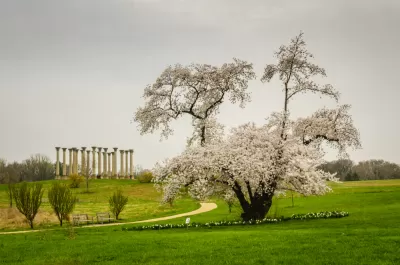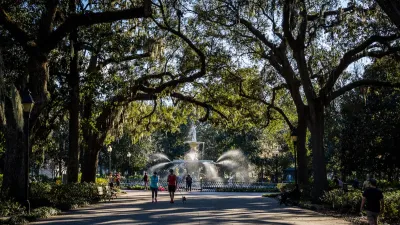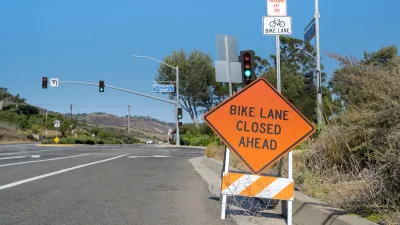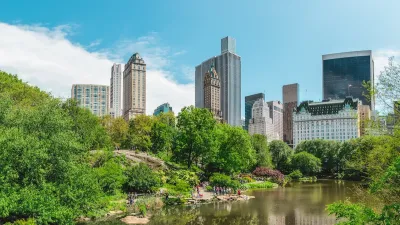Rain gardens and bioswales have allowed DC Water to scale back on the "gray infrastructure" it's building while still keeping rivers clean.

Next to Washington D.C.’s Piney Branch Parkway, right across from where that road intersects with 17th Street NW, CSO-049 serves the Rock Creek Sewershed, a 2,329-acre area of Washington D.C., with a diverse, mixed-income population of close to 90,000.
CSO-049 is the end of a pipe, part of D.C.’s sewer system. In an average year, 39.73 million gallons of combined stormwater and raw sewage flow out from CSO-049, dumping feces-polluted water into Piney Branch, which flows into Rock Creek just upstream from the Smithsonian’s National Zoo, and historic neighborhoods like Mount Pleasant, Dupont Circle, and Georgetown.
But most of the time, CSO-049 is dormant. The acronym “CSO” stands for “combined sewer overflow,” and CSO points like these are a feature of combined sewer systems designed and built mostly more than a century ago. In combined sewer systems, storm drains capture rainwater runoff — and any pollutants it picks up along the way — and sends it into the same sewers that collect wastewater from homes and businesses. On most rainy days, it all flows to wastewater treatment facilities that are supposed to remove toxins and other pollutants before releasing it back into natural bodies of water.
During heavier rainfall, however, combined sewer systems can’t handle the volume, sending the mixture directly out from overflow points like CSO-049, one of around 50 such overflow points in the District. And today, because of climate change, heavy storms are occurring more frequently, causing more of these overflow incidents in cities that have combined sewer systems.
Most cities facing this challenge have responded using what’s known as “gray infrastructure” — digging massive new underground tunnels or enlarging existing ones to capture and store stormwater until it can flow to wastewater treatment plants. An alternative, which a growing but still small number of cities are starting to embrace, is “green infrastructure” — rain gardens, bioswales, tree trenches, permeable pavement, green roofs and other forms that combine old and new technology to absorb more rainwater where it falls.
D.C. has already spent or committed nearly $2 billion over the past decade to building gray infrastructure, building massive tunnels deep beneath the Anacostia and Potomac rivers, as large as the tunnels that carry the region’s metro trains. But the District recently marked a major milestone in its gradual embrace of green infrastructure, declaring its first green infrastructure pilot project a success and shifting to a hybrid green-gray infrastructure approach for the final phases of its court-mandated, $2.7 billion stormwater management plan known as the Clean Rivers Project.
FULL STORY: ‘Green Infrastructure’ for Clean Water Shows Its Worth in Washington, D.C.

Trump Administration Could Effectively End Housing Voucher Program
Federal officials are eyeing major cuts to the Section 8 program that helps millions of low-income households pay rent.

Planetizen Federal Action Tracker
A weekly monitor of how Trump’s orders and actions are impacting planners and planning in America.

Ken Jennings Launches Transit Web Series
The Jeopardy champ wants you to ride public transit.

Washington Legislature Passes Rent Increase Cap
A bill that caps rent increases at 7 percent plus inflation is headed to the governor’s desk.

From Planning to Action: How LA County Is Rethinking Climate Resilience
Chief Sustainability Officer Rita Kampalath outlines the County’s shift from planning to implementation in its climate resilience efforts, emphasizing cross-departmental coordination, updated recovery strategies, and the need for flexible funding.

New Mexico Aging Department Commits to Helping Seniors Age ‘In Place’ and ‘Autonomously’ in New Draft Plan
As New Mexico’s population of seniors continues to grow, the state’s aging department is proposing expanded initiatives to help seniors maintain their autonomy while also supporting family caregivers.
Urban Design for Planners 1: Software Tools
This six-course series explores essential urban design concepts using open source software and equips planners with the tools they need to participate fully in the urban design process.
Planning for Universal Design
Learn the tools for implementing Universal Design in planning regulations.
Heyer Gruel & Associates PA
Ada County Highway District
Institute for Housing and Urban Development Studies (IHS)
City of Grandview
Harvard GSD Executive Education
Toledo-Lucas County Plan Commissions
Salt Lake City
NYU Wagner Graduate School of Public Service





























